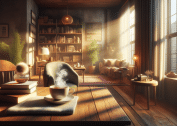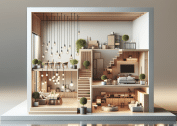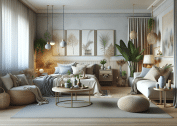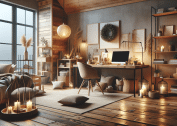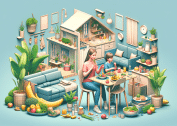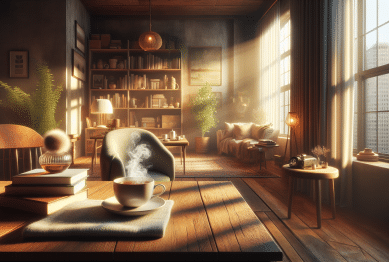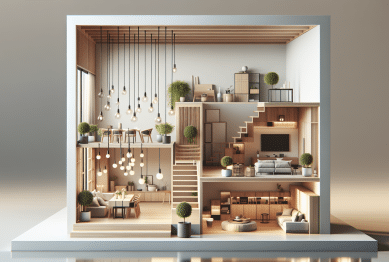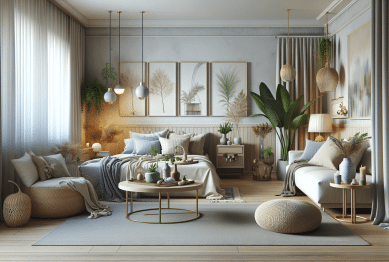Discover practical ways to refresh living spaces with easy and affordable home decor ideas. This guide reveals small design shifts that can dramatically enhance comfort, style, and mood—providing inspiration whether you rent or own your home.
Rethink Your Living Room Layout for Maximum Comfort
A well-organized living room can feel like an entirely new space, even without expensive renovations. Rearranging furniture to optimize flow often creates a welcoming atmosphere, making guests feel instantly at ease. Consider floating your sofa away from the walls. This design technique can define conversation zones and open up helpful walkways. Moreover, small adjustments like angling an accent chair or creating a central coffee table vignette add layers of visual intrigue and function. Simple moves like these do not require new purchases, just a willingness to experiment and observe how energy moves through the room. With a thoughtful approach, transforming a living room becomes more about intention than investment.
Natural lighting also plays a significant role in redefining comfort at home. Unblocking windows or choosing light-filtering drapes can dramatically increase perceived space in any room. Sheer curtains allow sunlight to illuminate the area, creating a cheerful effect that lifts spirits. If privacy is a concern, there are frosted film options that let daylight in while shielding the view. The right window treatments paired with strategic furniture placement give rooms an inviting glow, making daylight a central design ally. For those with smaller living quarters, maximizing natural light through mirrors cleverly expands the visual field. This tweak is especially effective in apartments or homes with limited windows.
Adding layers with rugs, throws, and textured pillows fine-tunes comfort and warmth. Soft fabrics and tactile materials offer both visual softness and physical coziness, transforming even stark rooms into relaxing retreats. Anchor the space with a large area rug, which helps tie together scattered seating. On sofas and armchairs, opt for throws in complementary tones to add dimension without demanding a full makeover. Textured elements also muffle sound, reducing echoes and fostering intimacy in shared spaces. These simple, strategic choices create a foundation where daily life feels a bit more inspired and restful, one detail at a time.
Small Art Upgrades Make an Oversized Impact
Artful decor offers a powerful way to express personality and keep a room visually engaging. Framed prints, original artwork, or even DIY wall pieces can instantly refresh a wall that once felt plain. Gallery walls, in particular, highlight collections of personal mementos, family photos, or eclectic art finds. Arranged thoughtfully, these groupings lend spaces a curated feel while telling a story. What’s most exciting is the flexibility: art can be swapped or rearranged as often as moods or seasons change. This approach makes each room dynamic and uniquely personal—perfect for those who love evolving trends but also crave lasting significance.
It’s not necessary to invest in expensive artwork. There are excellent resources online and at local art fairs where emerging artists offer affordable prints. Digital art is also rising in popularity. Consider printing favorite creative works and using interchangeable frames, which allow subtle updates without major commitments. Even leaning large canvases against a wall—rather than hanging—can create a relaxed and modern update. These artful touches liven up a room, sparking conversation and providing a fresh focal point with minimal fuss.
Bringing in three-dimensional elements like wall-mounted planters, sculptural shelves, or woven wall hangings introduces character beyond traditional paintings. Such additions create depth and play with texture, adding intrigue to even compact spaces. Rotating art and objects keeps rooms feeling lively and personal, fostering a creative home environment that reflects evolving tastes. As more people experiment at home, these small shifts in artistic display can yield substantial changes in both mood and perception of the living space.
Update Lighting to Set the Right Mood
Lighting is often referred to as the ‘unsung hero’ of home decor. Strategic fixtures can shape atmospheres for relaxation, productivity, or entertainment. Swapping out harsh overhead bulbs for warm, dimmable options gives control over ambiance. Lamps with layered heights—table, floor, and wall sconces—provide softness and depth, emphasizing the cozy or vibrant tone you wish to create. For renters, plug-in sconces or cordless LED lamps simplify updates and add effortless style. By paying close attention to lighting, anyone can transform a room’s energy and make it multifunctional.
Accent lighting, such as under-cabinet LEDs or picture frame lights, draws attention to favorite decor pieces and enhances visual structure. These lighting options are typically easy to install, budget-friendly, and offer immediate results. Multi-bulb fixtures or string lights can highlight architectural details and accentuate colors, breathing new life into forgotten corners of a home. Thoughtful lighting tape is simple to conceal and adds a touch of modern sophistication indoors.
Natural and artificial lighting work best together. Placement of mirrors opposite windows can amplify outdoor light during daytime hours, while well-chosen task lights ensure comfort in the evening. Layering sources is key: mix direct light for tasks with indirect light for general ambiance. By embracing both sunlight and thoughtfully chosen fixtures, it’s possible to adjust the energy of any space to match activities—truly making the home an adaptable haven throughout the day.
Bring Nature Indoors for Wellbeing and Beauty
Adding greenery is a proven way to boost both aesthetic appeal and emotional wellbeing in living spaces. Houseplants, ranging from resilient snake plants to lush ferns, not only purify the air but also introduce a calming, organic touch. Positioning plants near windows ensures optimal growth, while cluster groupings of small pots can give a sense of mini-indoor gardens. For those with limited floor space, wall-mounted planters or ceiling-hung macrame add life at every height. This infusion of green instantly brightens rooms and has positive effects on mood, concentration, and overall tranquility (Source: https://www.ncbi.nlm.nih.gov/pmc/articles/PMC4419447/).
If plant care seems daunting, there are low-maintenance options like succulents, ZZ plants, or pothos vines that thrive even with minimal sunlight and water. Modern interior design often pairs sleek, neutral decor with bold pots or stands for an effortless blend of style and function. Faux plants are another creative solution for high-traffic or dim corners—today’s varieties are remarkably lifelike, allowing everyone to enjoy a botanical atmosphere without ongoing maintenance. Introducing living or lifelike greenery is an affordable way to renew fatigue-prone rooms and promote a sense of freshness.
The benefits extend beyond aesthetics. Studies show indoor plants can lower stress, increase productivity, and even improve cognitive performance (Source: https://www.sciencedirect.com/science/article/pii/S0360132323000829). Their presence acts as a natural air filter and sets a peaceful tone, especially important in multipurpose areas used for both work and relaxation. Whether through a collection of leafy greens, a mini herb garden in the kitchen, or clever succulents on a bathroom shelf, bringing nature indoors remains a timeless—and scientifically backed—decor strategy.
Clever Storage Solutions Prevent Clutter
Clutter can quickly detract from even the most stylishly decorated room. Hidden storage and multifunctional furniture are invaluable allies for keeping homes orderly and visually appealing. Ottomans with lift-up tops, beds with built-in drawers, or stylish baskets tucked under consoles provide seamless organization. Small-space living especially benefits from vertical storage—tall bookshelves, wall hooks, and over-door racks turn unused surfaces into efficient problem-solvers. These solutions help maintain calm, reduce visual noise, and ensure every belonging has a place.
Decluttering often begins with an honest assessment of what’s used daily versus rarely touched items. Adopting a ‘one in, one out’ rule prevents future chaos while organizing possessions by function or frequency. Transparent bins in closets, labeled storage cubes, and under-bed boxes streamline the process, making clean-up and retrieval simple. Embracing these strategies is less about perfection and more about creating a supportive environment where decor shines and daily routines flow smoothly.
Visible storage doesn’t have to mean sacrificing style. Woven baskets, decorative boxes, or sleek open shelving keep everyday essentials within reach, functioning as both display areas and organizational tools. Whether storing magazines, children’s toys, or hobby supplies, thoughtfully chosen containers blend seamlessly with an overall design scheme. Ultimately, clever storage supports both tranquility and inspiration every day.
Play With Color and Patterns for Instant Personality
Introducing color—through paint, textiles, or decorative accents—remains one of the fastest ways to breathe life into a space. Even renters, often limited by strict lease agreements, can use removable wallpaper or bold area rugs to forge new moods. Pillows, throws, or even sets of dishes in surprising hues ignite a sense of vibrancy that energizes any room. Color psychology suggests blue tones bring calm, while yellows boost energy and optimism. By understanding how different shades affect mood, personalized spaces become more than visually pleasing—they encourage wellbeing throughout daily life.
Patterns are equally influential in dynamic home design. Chevron, stripes, or botanicals—whether on fabric, wallpaper, or art—layer visual excitement without overwhelming a room. Start small with patterned accent cushions or window treatments, then consider mixing patterns for a playful yet harmonious effect. Modern design recommendations highlight the importance of repeating a color or motif at least three times in a room to achieve balance. This approach unifies diverse design elements for a professional, lived-in feel.
Experimenting with color and pattern allows constant reinvention. Changing slipcovers, hanging vibrant art, or switching covers on lamp shades creates seasonal variations and keeps decor fresh. With so many affordable, temporary options available, incorporating bold colors or trendy prints does not risk long-term regret. Instead, it gives rooms new personalities as often as desired, ensuring home always feels uniquely personal and alive.
References
1. Lohr, V. I. (2010). Plants for human well-being. Retrieved from https://www.ncbi.nlm.nih.gov/pmc/articles/PMC4419447/
2. Bringslimark, T., Hartig, T., & Patil, G. G. (2009). The psychological benefits of indoor plants: A critical review of the experimental literature. Retrieved from https://www.sciencedirect.com/science/article/pii/S0360132323000829
3. US Environmental Protection Agency. (2022). Lighting choices save you money. Retrieved from https://www.energy.gov/energysaver/lighting-choices-save-you-money
4. American Psychological Association. (2023). Color psychology: How colors affect us. Retrieved from https://www.apa.org/topics/color
5. University of Minnesota Extension. (2021). Declutter your space for health and wellbeing. Retrieved from https://extension.umn.edu/personal-finance/declutter-your-space-health-and-well-being
6. The Spruce. (2022). Small living room ideas to maximize your space. Retrieved from https://www.thespruce.com/small-living-room-ideas-4137337


